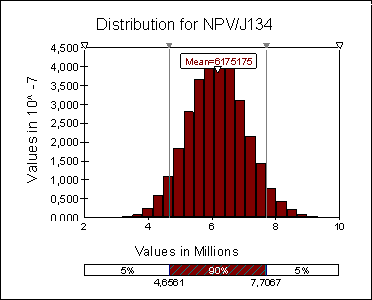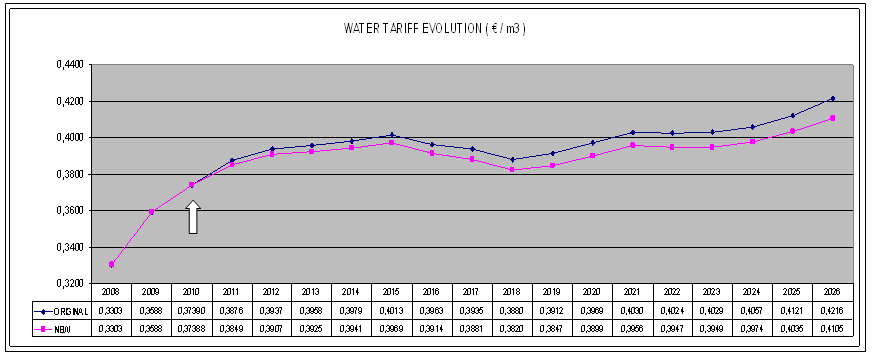
The government of Portugal has granted a 30 year licence (for the period 1996 – 2026) to Águas do Douro e Paiva (AdDP), to treat and supply water to the local water distribution companies in the country’s Oporto region. With a population of over 1.7 million, this region in Northern Portugal includes the country's second largest city, Oporto, and 19 other towns around it. AdDP currently has four water treatment plants and 25 water pumping stations. It is also looking into extending its licence to cover treatment of waste water.
AdDP’s Engineering Department used @RISK, our Monte Carlo simulation tool, for a study to determine the impact of building a new power sub-station in the town of Jovim, on the company’s energy costs, and hence on water tariffs. A similar study was conducted to estimate the impact of refurbishing some of the existing water pumping stations, on the energy costs.
The building of the new power sub-station is crucial to AdDP – such equipment qualifies AdDP to receive high voltage power, which has the lowest power tariff and therefore helps reduce the company’s overall energy costs. As the company’s major water pumping stations are located near the power sub-station site, it means that these sites too can benefit from the lower tariff, which in turn impacts on the water tariffs that AdDP charges the water distribution companies in the Oporto region.
This study helped AdDP determine the potential Net Present Value (NPV) of this project, the key financial indicator of its success.
Reducing Energy Costs Is Crucial
Because they directly impact water tariffs, energy costs have an enormous impact on the financial management of water supply companies. As a water utility company under government supervision, AdDP needs to minimise the water tariff it charges whilst breaking even financially. With energy costs forming a large proportion of AdDP's overall expenditure, it is crucial that these are minimised to ensure minimal increases to water tariffs. For instance, in 2007, AdDP’s energy costs stood at €5.2 million, accounting for a substantial 29 per cent of its operational costs.
Jaime Gabriel Silva, Director of Engineering at AdDP, comments, “Since 1996, we have offered one of the lowest water tariffs in Portugal. This is a badge of honour for AdDP”.
“More importantly, every year AdDP has to secure approval from the Portuguese regulatory authority on any revisions it proposes to its water tariff. The company’s financial plans are minutely scrutinised to ensure that the water tariff increase is justified and minimised.”
One of the main challenges the company faces is that the energy costs vary significantly year on year, which in turn impacts the water tariff. The factors that impact energy costs include the type of power supplied to the water pumping stations and treatment plants, the level of energy utilisation during the day and the energy tariff package offered to AdDP by power supply companies. In addition, the uncertainty of future energy tariff inflation rates affects cost estimates, along with the decreasing water consumption trend in larger towns – all impacting the NPV of this project.
To elaborate, the type of power supplied to AdDP by the energy company could be high, medium or low voltage, with the lowest tariff being for high voltage usage. However, for AdDP to use high voltage power supply, it must have its own power sub-station. AdDP has just one location that uses high voltage, where it has two power sub-stations. Hence, the construction of the new power sub-station is crucial. In addition, the amount of different types of power utilised during different times of the day also impacts on the energy costs.
For example, the energy cost in a day will be determined by the types of power utilised such as high, medium or low voltage power; the corresponding lengths of usage of those power types, i.e. for long, medium or short periods; and used during which times of day such as peak hours or off-peak hours. Therefore, high voltage power used over a long period is more economical, but high voltage power is more expensive during peak hours in the day, as opposed to off-peak hours at night. Finally, the nature of the energy tariff package negotiated by AdDP in terms of level of utilisation allowed and discounts offered by power companies also affect costs. For instance, the energy tariff for a particular power type may be higher during certain times of the day, but AdDP may benefit from discounts if it uses that power type during off-peak hours.
Director of Engineering, Águas do Douro e Paiva
Risk Analysis Determines Energy Saving Tactics and NPV of Project
AdDP used @RISK, to determine ways by which energy costs could be reduced. These included measures such as determining most economical combination of power types, extent of usage of those power types and negotiating energy tariff discounts as a result of the construction of the new power sub-station; along with improving the performance of its eight water pumping stations to reduce energy consumption.
Additionally, the volume of water that AdDP needs to supply to each of the 20 towns’ water distribution companies impacts on the level of energy it uses and hence the overall energy costs. However, accurately forecasting the future demand of water is challenging as it varies year on year. For instance, water consumption is increasing in some towns as a result of increase in population, but in others, especially the bigger ones, it is decreasing due to construction of new and more efficient water supply networks.
AdDP used @RISK to build a model that simulated the different scenarios of energy costs. This enabled it to determine the impact of variables – i.e. future energy inflation rate, water consumption, new infrastructure and plant maintenance costs, and land and project licence costs.
Based on this quantitative risk analysis, AdDP concluded that the project NPV, which is the key financial indicator of its success, would be around €6 million. Because energy expenditure forms a large proportion of the overall operational cost of water supply management, it directly impacts the NPV of projects. Therefore, the greater the estimated reduction in energy costs, the higher the NPV.
Silva said, “@RISK clearly lists all the outputs for the different variables resulting from the simulations, but more importantly highlights the statistical errors that occur during the simulations. Because the tool is Excel-based, it is very easy to make changes to the model in order to eliminate these errors. This gave us tremendous confidence that our model was well prepared and realistic.”
Additionally, AdDP was able to easily create graphs for every single output from the simulations. These illustrations were a key tool for interpreting the results, and also helped to describe and share them with the other people involved in the decision-making process.
Based on the conclusions of the study, in 2008, AdDP’s management decided to go ahead with the design of the power sub-station, contracting a specialised firm to identify the location for the sub-station, and estimate construction costs of the project.
On satisfactory completion of the internal review process of the project design and costs, AdDP management is looking to submit the project proposal to the Portuguese energy authority (Direcção Geral de Energia) to obtain the necessary project licenses; and to the energy company, to obtain details of the costs and availability of power supply to the site. Post completion of all these formalities, there is a high probability that the project will get the “green light” for construction during 2009.
Additional Information
Distributions Used PERT and Triangular distributions were used for this study, in most cases combined with the aid of alternate parameters, which allow risk analysts to define distributions entering values for specific percentile locations of an input distribution as opposed to simply using its traditional arguments. For instance, it is possible to define a PERT or a Triangular distribution with the 5% and 95% percentiles, instead of the traditional 0% and 100% boundaries, making distributions assessment easier.
Water consumption is continuously fluctuating in the region, primarily due to changes in population and construction of newer and more efficient water networks. AdDP was unable to accurately estimate future water consumption using theoretical distributions. These distributions are more pragmatic to use to model inputs in situations when there isn’t much information available.
Quantitative Techniques Used The analysis was developed as a Discounted Cash Flow Model. All inputs were described as quantitative scales with the main output being the Net Present Value (NPV) of the project valued in Euros.
Graphs
Graph 1 below shows that, for this project, with the volumes of water estimated to be pumped, along with the associated energy and power sub-station construction costs, the expected NPV is around €6 million. There is a 90% probability of a NPV between €4.6 and €7.7 million and the probability of the NPV falling below €4.6 million is only 5%.

Graph 1: Histogram illustrating distribution of NPV
Graph 2, below, shows the estimated water tariff evolution from 2008 until 2026. The blue line shows the actual evolution in water tariff, in 2008 and during 2009 to 2026, under present conditions. The pink line in the graph shows the positive impact of savings in energy costs on the water tariff for the same period, as a result of implementation of the Jovim sub-station project and the refurbishment of some AdDP’s pumping station.

Graph 2: Water tariff evolution – estimate created in Excel using @RISK analysis results
